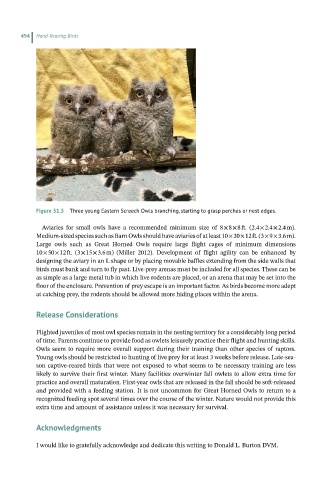Page 498 - Hand rearing birds second
P. 498
494 Hand-Rearing Birds
Figure31.5 Three young Eastern Screech Owls branching, starting to grasp perches or nest edges.
Aviaries for small owls have a recommended minimum size of 8 × 8 × 8 ft. (2.4 × 2.4 × 2.4 m).
Medium‐sized species such as Barn Owls should have aviaries of at least 10 × 30 × 12 ft. (3 × 9 × 3.6 m).
Large owls such as Great Horned Owls require large flight cages of minimum dimensions
10 × 50 × 12 ft. (3 × 15 × 3.6 m) (Miller 2012). Development of flight agility can be enhanced by
designing the aviary in an L shape or by placing movable baffles extending from the side walls that
birds must bank and turn to fly past. Live‐prey arenas must be included for all species. These can be
as simple as a large metal tub in which live rodents are placed, or an arena that may be set into the
floor of the enclosure. Prevention of prey escape is an important factor. As birds become more adept
at catching prey, the rodents should be allowed more hiding places within the arena.
ReleaseConsiderations
Flighted juveniles of most owl species remain in the nesting territory for a considerably long period
of time. Parents continue to provide food as owlets leisurely practice their flight and hunting skills.
Owls seem to require more overall support during their training than other species of raptors.
Young owls should be restricted to hunting of live prey for at least 3 weeks before release. Late‐sea-
son captive‐reared birds that were not exposed to what seems to be necessary training are less
likely to survive their first winter. Many facilities overwinter fall owlets to allow extra time for
practice and overall maturation. First‐year owls that are released in the fall should be soft‐released
and provided with a feeding station. It is not uncommon for Great Horned Owls to return to a
recognized feeding spot several times over the course of the winter. Nature would not provide this
extra time and amount of assistance unless it was necessary for survival.
Acknowledgments
I would like to gratefully acknowledge and dedicate this writing to Donald L. Burton DVM.

